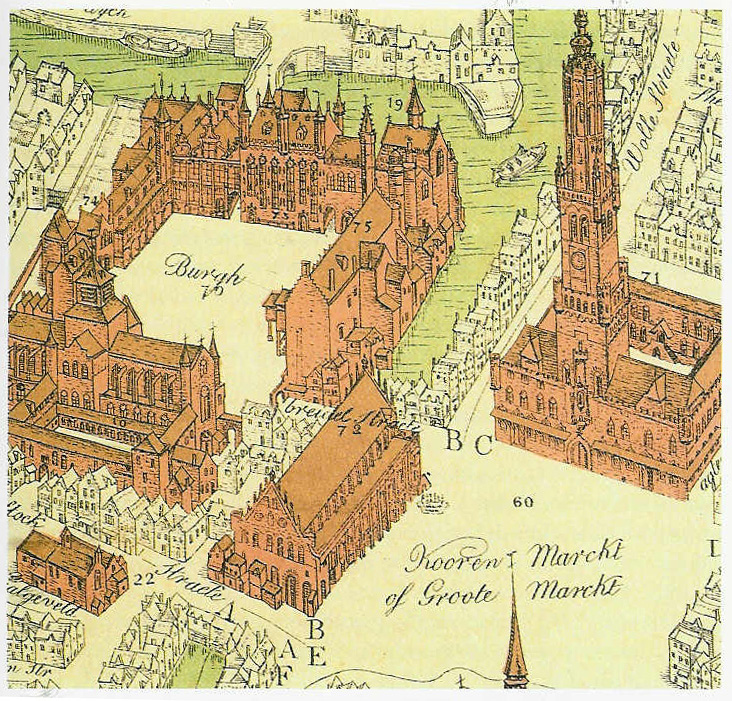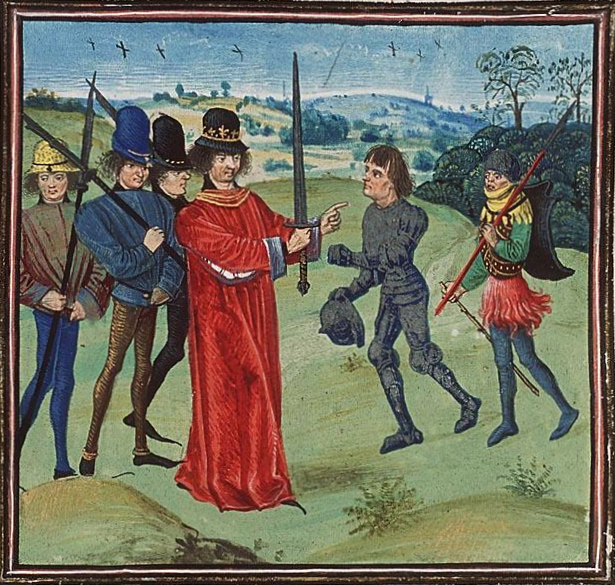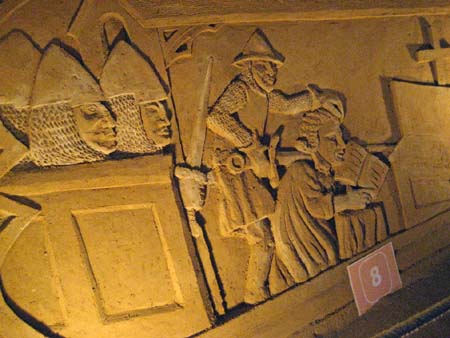|
Het Steen (Bruges)
Het Steen was a medieval building on the Burg Square in Bruges, Belgium. Between the late 11th and late 13th centuries, it served as the residence of the Counts of Flanders.Brigitte Beernaert, 'Het Steen. Een benadering van de vroegere Brugse gevangenis', in ''Van middeleeuwen tot heden. Bladeren door Brugse kunst en geschiedenis'', Brugge, 1983. History It is not clear whether the building was a successor to the ''Oude Steen'', which is on ''Wollestraat'' – in the oldest part of the city – and which has cornerstones dating back to the 11th or 12th century. Steen Castle may also date from that period, but little is known about its early history. It is likely that it was built to replace a wooden structure. According to historians, the first stone building - a keep - was built between 863 and 965 by Count Baldwin I, Count Baldwin II or Count Arnulf I. Another historian has dated the building to the reign of Count Baldwin V (1035 – 1067). The first definite date that c ... [...More Info...] [...Related Items...] OR: [Wikipedia] [Google] [Baidu] |
Brugge - Waterhalle 1294 - 1787
Bruges ( , nl, Brugge ) is the capital and largest city of the province of West Flanders in the Flemish Region of Belgium, in the northwest of the country, and the sixth-largest city of the country by population. The area of the whole city amounts to more than 13,840 hectares (138.4 km2; 53.44 sq miles), including 1,075 hectares off the coast, at Zeebrugge (from , meaning 'Bruges by the Sea'). The historic city centre is a prominent World Heritage Site of UNESCO. It is oval in shape and about 430 hectares in size. The city's total population is 117,073 (1 January 2008),Statistics Belgium; ''Population de droit par commune au 1 janvier 2008'' (excel-file) Population of all municipalities in Belgium, as of 1 January 2008. Retrieved on 19 October 2008. [...More Info...] [...Related Items...] OR: [Wikipedia] [Google] [Baidu] |
Middle Ages
In the history of Europe, the Middle Ages or medieval period lasted approximately from the late 5th to the late 15th centuries, similar to the post-classical period of global history. It began with the fall of the Western Roman Empire and transitioned into the Renaissance and the Age of Discovery. The Middle Ages is the middle period of the three traditional divisions of Western history: classical antiquity, the medieval period, and the modern period. The medieval period is itself subdivided into the Early, High, and Late Middle Ages. Population decline, counterurbanisation, the collapse of centralized authority, invasions, and mass migrations of tribes, which had begun in late antiquity, continued into the Early Middle Ages. The large-scale movements of the Migration Period, including various Germanic peoples, formed new kingdoms in what remained of the Western Roman Empire. In the 7th century, North Africa and the Middle East—most recently part of the Eastern Ro ... [...More Info...] [...Related Items...] OR: [Wikipedia] [Google] [Baidu] |
Burg Square (Bruges)
Burg Square is a square and former fortress in Bruges. It is one of the main squares of the city. History The Burg was originally surrounded by walls and had entrance gates. It is one of the oldest parts of the city centre. The fortress was located at the meeting-point of the Oudenburg-Aardenburg Roman road (the ''Zandstraat'') and the Reie canal. The fortress was around one hectare in size. Count Arnulf I of Flanders (889-965) extended the Bruges fortress to create a powerful, imperial administrative centre of one and a half hectares. ''Steen'' Castle, which was one of the residences of the Counts of Flanders, was located on the western side of the square from the 11th century until the end of the 13th century. The castle church—which was dedicated to Our Lady and Saint Donatian—was built to the north, within the fortifications, and a chapter of canons was later established. This gave the fortress a dual purpose: the southern part served a civil purpose and the northern pa ... [...More Info...] [...Related Items...] OR: [Wikipedia] [Google] [Baidu] |
Bruges
Bruges ( , nl, Brugge ) is the capital and largest City status in Belgium, city of the Provinces of Belgium, province of West Flanders in the Flemish Region of Belgium, in the northwest of the country, and the sixth-largest city of the country by population. The area of the whole city amounts to more than 13,840 hectares (138.4 km2; 53.44 sq miles), including 1,075 hectares off the coast, at Zeebrugge (from , meaning 'Bruges by the Sea'). The historic city centre is a prominent World Heritage Site of UNESCO. It is oval in shape and about 430 hectares in size. The city's total population is 117,073 (1 January 2008),Statistics Belgium; ''Population de droit par commune au 1 janvier 2008'' (excel-file) Population of all municipalities in Belgium, as of 1 ... [...More Info...] [...Related Items...] OR: [Wikipedia] [Google] [Baidu] |
Count Of Flanders
The count of Flanders was the ruler or sub-ruler of the county of Flanders, beginning in the 9th century. Later, the title would be held for a time, by the rulers of the Holy Roman Empire and Spain. During the French Revolution, in 1790, the county of Flanders was annexed to France and ceased to exist. In the 19th century, the title was appropriated by Belgium and granted twice to younger sons of Belgian kings. The most recent holder died in 1983. In 862 Baldwin I was appointed as the first Margrave of Flanders by King Charles II. It was a military appointment, responsible for repelling the Viking raids from the coast of Francia. The title of margrave (or marquis) evolved into that of count. Arnulf I was the first to name himself as count, by the Grace of God. The title of margrave largely fell out of use by the 12th century. Since then, the rulers of Flanders have only been referred to as counts. The counts of Flanders enlarged their estate through a series of diplomatic mar ... [...More Info...] [...Related Items...] OR: [Wikipedia] [Google] [Baidu] |
Baldwin I Of Flanders
Baldwin I (probably 830s – 879), also known as Baldwin Iron Arm ( nl, Boudewijn met de IJzeren Arm; the epithet is first recorded in the 12th century), was the first margrave of Flanders, which evolved into the County of Flanders. He was the son of Odoacer. Odoacer was the son of Enguerrand delle Fiandre. Enguerrand delle Fiandre was the son of Liederik. Elopement with princess At the time Baldwin first appears in the records he was already a count, presumably in the area of Flanders, but this is not known. Count Baldwin rose to prominence when he eloped with Judith, daughter of Charles the Bald, king of West Francia. Judith had previously been married to Æthelwulf and Æthelbald, kings of Wessex, but after the latter's death in 860, she returned to France. Around the Christmas of 861, at the instigation of Baldwin and with her brother Louis's consent, Judith escaped the custody into which she had been placed in the city of Senlis, Oise after her return from England. Sh ... [...More Info...] [...Related Items...] OR: [Wikipedia] [Google] [Baidu] |
Baldwin II Of Flanders
Baldwin II ( 865 – 10 September 918) was the second margrave (or count) of Flanders, ruling from 879 to 918. He was nicknamed the Bald (''Calvus'') after his maternal grandfather, Emperor Charles the Bald. Rule Baldwin II was born around 865 to Margrave Baldwin I of Flanders and Judith, daughter of Emperor Charles the Bald.Detlev Schwennicke, '' Europäische Stammtafeln: Stammtafeln zur Geschichte der Europäischen Staaten'', Neue Folge, Band II (Verlag von J. A. Stargardt, Marburg, Germany, 1984), Tafel 5 The early years of Baldwin II's rule were marked by a series of devastating Viking raids into Flanders.David Nicholas, Medieval Flanders (Longman Group UK, Ltd., 1992)pp. 17–18 By 883, he was forced to move north to Pagus Flandransis, which became the territory most closely associated with the Counts of Flanders. Baldwin constructed a series of wooden fortifications at Saint-Omer, Bruges, Ghent, and Kortrijk. He then seized lands that were abandoned by royal and ecclesi ... [...More Info...] [...Related Items...] OR: [Wikipedia] [Google] [Baidu] |
Arnulf I, Count Of Flanders
Arnulf I (c. 893/899 – 27 March 965), called "the Great", was the first Count of Flanders. Life Arnulf was the son of margrave Baldwin II of Flanders and Ælfthryth of Wessex, daughter of Alfred the Great.Detlev Schwennicke, '' Europäische Stammtafeln: Stammtafeln zur Geschichte der Europäischen Staaten'', Neue Folge, Band II (Verlag von J. A. Stargardt, Marburg, Germany, 1984), Tafel 5 Through his mother he was a descendant of the Anglo-Saxon kings of England, and through his father, a descendant of Charlemagne.''The Annals of Flodoard of Reims, 919–966'', ed. Steven Fanning & Bernard S. Bachrach (University of Toronto Press, CA, 2011), p. xx Presumably Arnulf was named either after Saint Arnulf of Metz, a progenitor of the Carolingian dynasty, or King Arnulf of Carinthia, whom his father supported. At the death of their father in 918, Arnulf became Count of Flanders while his brother Adeloft or Adelolf succeeded to the County of Boulogne. However, in 933 Adeloft died, an ... [...More Info...] [...Related Items...] OR: [Wikipedia] [Google] [Baidu] |
Baldwin V, Count Of Flanders
Baldwin V ( 1012 – 1 September 1067) was Count of Flanders from 1035 until his death. He secured the personal union between the counties of Flanders and Hainaut and maintained close links to the Anglo-Saxon monarchy, which was overthrown by his son-in-law, William the Conqueror, near the end of his life. Family Baldwin was born into the House of Flanders, the son of Baldwin IV of Flanders and Ogive of Luxembourg. Baldwin married Adela, daughter of King Robert II of France, in 1028 in Amiens; at her instigation he rebelled against his father but in 1030 peace was sworn and the old count continued to rule until his death. The couple had three children: Baldwin VI (1030–1070), Matilda ( 1031–1083), who was married to William the Conqueror, and Robert I ( 1033–1093). Career During a long war (1046–1056) as an ally of Duke Godfrey III of Lower Lorraine against Emperor Henry III, Baldwin initially lost Valenciennes to Count Herman of Mons. However, when the latter died in ... [...More Info...] [...Related Items...] OR: [Wikipedia] [Google] [Baidu] |
Galbert Of Bruges
Galbert of Bruges (Galbertus notarius Brugensis in Latin) was a Flemish cleric and chronicler. A resident of Bruges and a functionary in the administration of the count of Flanders, he is known for his day-by-day Latin account ''De multro, traditione et occisione gloriosi Karoli comitis Flandriarum'' of the events surrounding the murder of Count Charles the Good, in 1127 and its aftermath up through the accession of Thierry of Alsace in summer 1128. References *Jeff Rider (translator). 2013. ''The Murder, Betrayal, and Slaughter of the Glorious Charles, Count of Flanders'' by Galbert of Bruges. New Haven and London: Yale University Press. . *Jeff Rider (editor). 1994. ''De multro, traditione, et occisione gloriosi Karoli comitis Flandriarum''. Turnhout, Belgium: Brepols. . *Jeff Rider. 2001. ''God's Scribe: The Historiographical Art of Galbert of Bruges''. Washington, DC: Catholic University of America Press. . *Jeff Rider and Alan V. Murray (editors). 2009. ''Galbert of Bruges ... [...More Info...] [...Related Items...] OR: [Wikipedia] [Google] [Baidu] |
Blessed Charles The Good, Count Of Flanders
Charles the Good (10842 March 1127) was Count of Flanders from 1119 to 1127. His murder and its aftermath were chronicled by Galbert of Bruges. He was beatified by Pope Leo XIII in 1882 through ''cultus'' ''confirmation''. Early life Charles was born in Denmark, only son of the three children of King Canute IV (Saint Canute) and Adela of Flanders. His father was assassinated in Odense Cathedral in 1086, and Adela fled back to Flanders, taking the very young Charles with her but leaving her twin daughters Ingeborg and Cecilia in Denmark. Charles grew up at the comital court of his grandfather Robert I of Flanders and uncle Robert II of Flanders. In 1092 Adela went to southern Italy to marry Roger Borsa, duke of Apulia, leaving Charles in Flanders. Charles travelled to the Holy Land in 1107 or 1108 with a fleet of English, Danes and Flemings. This is possibly the fleet of Guynemer of Boulogne, described similarly. He was offered the crown of the Kingdom of Jerusalem but r ... [...More Info...] [...Related Items...] OR: [Wikipedia] [Google] [Baidu] |

.jpg)



